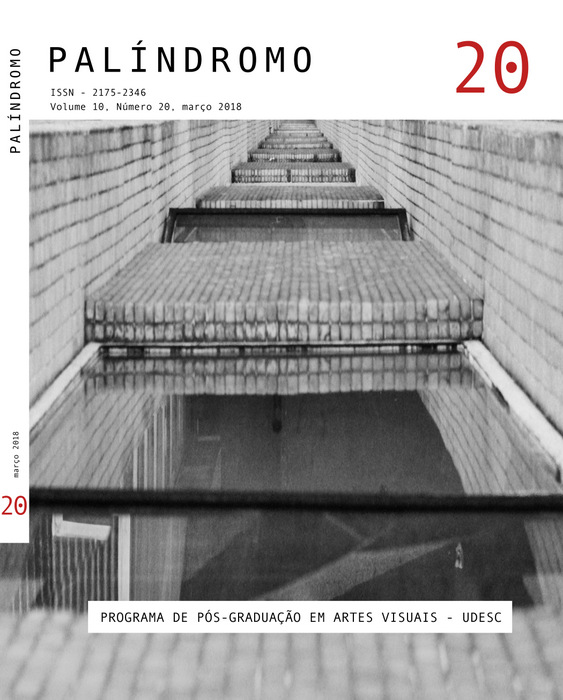Expositions in the research catalog / Exposições no catálogo de pesquisa
DOI :
https://doi.org/10.5965/2175234609202018010Résumé
O Research Catalog, RC (Catálogo de Pesquisa)e o Journal for Artistic Research, JAR (Revista de Pesquisa Artística)são projetos interligados, mas com metas e propósitos muito diferentes. O RC é um espaço de trabalho gratuito online e basicamente privativo que permite a (auto-)publicação e pesquisa artística. JAR é um periódico acadêmico, avaliado pelos pares, de livre acesso, para a publicação e disseminação de pesquisa artística. JAR atua como o primeiro de uma série de portais planejados, especializados para pesquisas selecionadas publicadas no RC que utilizam a tecnologia disponibilizada, incluindo a interface de design e o procedimento integrado de envio e publicação.Téléchargements
Références
Borgdorff, H., 2012. The Conflict of the Faculties. Perspectives on Artistic Research and Academia. Leiden: Leiden University Press.
Buchloh, B.H.D., 2000. Neo-Avantgarde and Culture Industry: Essays on European and American Art from 1955 to 1975. Cambridge, MA, & London: MIT Press.
Burger, P., 1984. Theory of the Avant-Garde. Minneapolis, MN, & London: University of Minnesota Press.
Busch, K., 2011. ‘Generating Knowledge in the Arts – A Philosophical Daydream.’ Te x-te zur Kunst (82), pp. 70-79.
Elo, M. (ed.), 2007. Here Then: The Photograph as Work of Art and as Research. Hel-sinki: Finnish Academy of Arts.
Munch, R., 2011. Akademischer Kapitalismus: Über die politische Ökonomie der Ho-chschulreform Originalausgabe. Berlin: Suhrkamp Verlag.
Osborne, P., 2013. Anywhere or Not at All: Philosophy of Contemporary Art. London and NewYork: Verso.
Schwab, M., 2008. ‘First, the Second: Walter Benjamin’s Theory of Reflection and the Question of Artistic Research.’ Journal of Visual Art Practice 7(3), pp. 213-223.
Schwab, M., 2009a. ‘First the Second: The Supplemental Function of Research in Art.’ In: Artand Artistic Research: Music, Visual Art, Design, Literature, Dance. Zurich Year-book of the Arts, C. Caduff, F. Siegenthaler, & T. Walchli (eds.). Zurich: Zurich Univer-sity of the Arts/Scheidegger & Spiess, pp. 56-65.
Schwab, M., 2009b. ‘The Power of Deconstruction in Artistic Research.’ Working Pa-pers in Art & Design 5. Available at: http://sitem.herts.ac.uk/artdes_research/papers/wpades/vol5/msfull.html [Accessed 20 November 2012].
Schwab, M., 2011. ‘Editorial.’ JAR 0. Available at: http://www.jar-online.net/index.php/issues/editorial/480 [Accessed 20 November 2012].
Schwab, M., 2012a. ‘Between a Rock and a Hard Place.’ In: Intellectual Birdhouse: Ar-tistic Practice as Research. F. Dombois et al. (eds.). London: Koenig Books, pp. 229-47.
Schwab, M., 2012b. ‘Exposition Writing.’ In Yearbook for Artistic Research & Develop-ment. Stockholm: Swedish Research Council, pp. 16-26.
Schwab, M., 2012c. ‘The Research Catalogue as Model for Dissertations and Theses in Art andDesign.’ In: The Sage Handbook of Digital Dissertations and Theses. R. An-drews et al.(eds.). London, Thousand Oaks, New Delhi: Sage.
Sheikh, S., 2006. ‘Spaces for Thinking: Perspectives on the Art Academy.’ Texte zur Kunst (62,June). Available at: http://www.textezurkunst.de/62/spaces-for-thinking/ [Accessed 20 November 2012].
Téléchargements
Publiée
Comment citer
Numéro
Rubrique
Licence
(c) Tous droits réservés Palíndromo 2018

Ce travail est disponible sous la licence Creative Commons Attribution 4.0 International .
DECLARAÇÃO DE DIREITOS AUTORAIS
a. Os artigos publicados pela revista são de uso gratuito, destinados a aplicações acadêmicas e não comerciais. Todos os direitos autorais são atribuídos à revista. Os artigos cujos autores são identificados representam a expressão do ponto de vista de seus autores e não a posição oficial da Revista Palíndromo. O (s) autor (es) compromete-se sempre que publicar material referente ao artigo publicado no Palíndromo mencionar esta publicação da seguinte forma:
Este artigo foi publicado originalmente pela revista Palíndromo em seu volume (coloque o volume), número (coloque o número) no ano de (coloque o ano) e pode ser acessado em: http://www.revistas.udesc.br/index.php/palindromo
b. Plágio, em todas as suas formas, constitui um comportamento antiético de publicação e é inaceitável. A revista Palíndromo utiliza o software iThenticate de controle de similaridade


